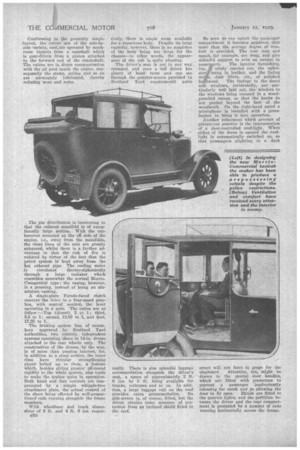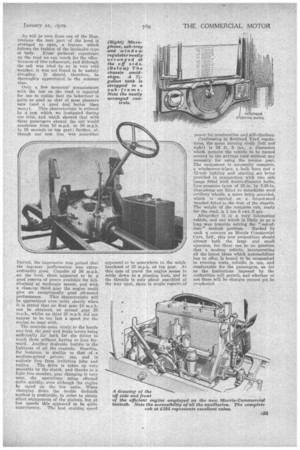THE MORRIS-COMMERCIAL LONDON-TYPE TAXICAB.
Page 13

Page 14

Page 15

If you've noticed an error in this article please click here to report it so we can fix it.
Technical Description and Road Trial of a Well-equipped Vehicle which Conforms with the Requirements of Scotland Yard.
FOR several years past there has been a continued trenchant criticism, in which The Commercial Motor has taken a leading part, of the obsolescent nature of our British taxicabs and, in particular, the type employed in London ; engines, chassis details generally, and bodywork have all come within the scope of the critics, who have insistently demanded a better general level of efficiency. This state of affairs is likely to be altered in the not too distant future, because one of the great champions of cheap transport, Mr. W. R. Morris, has set .about producing a thoroughly up-to-date and well-equipped taxicab to sell at the moderate figure of M5.
As might be expected, Morris Commercial' Cars, .Ltd,, is manufacturing this new product, but the financial and distributing arrangements are being handled by an entirely separate concern —the International Taxicab Co., Ltd., the head Offices of which are at Wentworth Chambers, Pinstone Street, Sheffield, Mr. George Kenning, J.P.,.the well-known motor trader, being the managing director.
This new Morris-Commercial product represents a distinct advance in design upon what has been considered "good enough" in the past. As will be seer] from the photographs, the whole ensemble has distinctly good lines, and from the point of viewof refinement in detail, leaves little to be desired. Indeed, many of the interior appointments are similar to those found on saloon private cars. Communication with the driver, for instance, is arranged by means of a microphone, which is, of course, an obvious improvement upon the old-fashioned and unhygienic spealting-tube. Again, all the windows and screens are of safety glass, so that passengers are freed from what was once a serious danger.
As we found from a trial on the road, 50 m.p.h. could be attained without undue noise emanating from beneath the bonnet, whilst, in addition, we can vouch for the excellence of
• the suspension, as we drove a cab at speed over several stretches of road with atrocious surfaces in the vicinity a MorrisCommercial works at Smethwiek, without any suspicion of harshness being apparent. before attempting to give any further indication of the vehicle's potentialities, so far all road performance is concerned; it would seers opportune now to give a brief description of the chassis. Broadly speaking, the layout for all the main components follow very largely upon accepted Morris-Commercial practice; thus the engine, dutch, and gearbox are built unit-wise and suspended in the frame at three points, whilst the drive is transmitted to the overhead worm of the rear axle by means Of an encl(Aed tubular propeller shaft. The chassis is suspended on semi-elliptic springs at the front and rear, all of which are damped by Smith's shock absorbers—a feature of the design which doubtlessly attributes in no small manner to the all-round excellence of the suspension.
Clean lines characterize the layout for the power unit, the off side being particularly neatly arranged. The four cylinders are cast in one with the crankcase ; the bore is 80 mm. and the piston stroke 125 mm., dimensions which provide an R.A.C. rating of 15.9 h.p. The crankcase is well ribbed internally, and being of a deep section, forms a stiff bracing for the three bearings which carry the 'crankshaft. Dura inmin connecting rods and diecast aluminium pistons combine to make the unit vibrationless throughout its speed range; they also assist in making it very lively. Oil is fed to the crankshaft and camshaft bearings by a plunger Pump, which is submerged in the oil in the sump and surrounded by a gauze filter. The connecting-rod big-end bearings are also fed with oil under pressure through passages drilled in the crankshaft.
Conforming to the generally simple layout, the valvesare of the side-byside variety, and,,are operated by mushroom tappets from a camshaft which is b.,'eardriven from a pinion attached to the forward end of the crankshaft. The valves are in direct communication with the oil mist inside the engine, consequently the stems, guides and so. on are adequately lubricated, thereby reducing wear and noise.
The gas distribution is interesting in that the exhaust manifold is of exceptionally large Section. With the carburetter mounted on the off side of the engine, i.e., away from the manifolds, the clean lines of the unit are greatly enhanced, whilst there is a further advantage in that the risk of fire is reduced by virtue of the fact that the petrol system is kept away from the hot exhaust pipe. The cooling water
is circulated thermo-siplionically through a large radiator which resembles somewhat the normal MorrisCommercial type; the easing, however, is a pressing, instead of being an aluminium casting.
A single-plate Ferodo-faced clutch conveys the drive to a four-speed gearbox, with central control, the lever operating in a gate. The ratios are as follow:—Top (direct), 5 to 1; third, 8.5 to 1 ; second, 12.05 to 1, and first, 17.25 to 1.
The braking system has, of course, been approved, by Scotland Yard authorities, two entirely independent systems operating shoes in 14-in, drums attached to the rear wheels only. The construction of the drums, by the way, is of more than passing interest, for, in addition to a stout section, the inner rims have circular strengthening pieces bolted up to them, a feature which, besides giving' greater all-round rigidity to the whole system, also tends to make the brakes quiet in operation. Both hand and foot controls are compensated by a simple whipple-tree attachment plate, the actual control of the shoes being effected by well-proportioned rods running alongside the frame members.
With wheelbase and track dimensions of 9 ft. and 4 ft. 8 ins. respee
tively, there is ample room available for a capacious body. Despite its large capacity, however, 'there is no suspicion of the body being too large for the chassis—in other words, the appearance Of the cab is quite pleasing.
The driver's seat is not in any way cramped, and even a tall driver has plenty of head room and can see through the quarter-screen provided • (a Scotland Yard requirement), quite easily. There is also splendid luggage accommodation alongside the driver's seat, a space of approximately 2 ft. 6 ins. by 3 ft. being available for trunks, suitcases and so on. In addition, a large luggage rail on the roof provides extra accommodation. No side-screen is, of course, fitted, but the driver obtains some measure of protection from an inclined shield fitted to the roof. So soon as one enters the passenger compartment it becomes apparent that more than the average degree of cornfort is provided. The rear seat and squab. for example, are deep, and give splendid support to even an outsize in passe -ers. The interior furnishing, too, nicely carried out, the uphol ster being in leather, and the facing str s, door fillets, etc., of polished.
hs wood. The facings to the doora add windows, incidentally, are particularly well laid out, the winders to the windows being encased in a woodpanelled recess, so that the knobs do not project beyond the face of the woodwork. On the right-hand panel a microphone is installed with a pressbutton to bring it into operation.
Another refinement which savours of private-car practice is the incorporation of a door-controlled roof-light. When either of the doors is opened the rooflight is automatically switched on, so that passengers alighting in a dark street will not have to grope for the stepboard. Attention, too, might be drawn to the special door handles, which are fitted with protectors to prevent a passenger inadvertently releasing the catch and so allowing the door to fly open. Blinds are fitted to the quarter lights, and the partition between the driver and the rear compartment is protected by a number of rods running horizontally across the frame. As will be seen from one of the illustrations the rear part of the hood is mauged to open, a feature which follows the fashion of the laudaulet type of. body. From personal experience on the road we can winch for the effectiveness of this refinement, and although the cab was tried by us in very cold weather, it was not found to be unduly draughty. It should, therefore, be thoroughly appreciated in the summer time.
Only a few moments' acquaintance with the cab on the road is required for one to realize that its behaviour is quite as good as that of most pleasure cars (and a good deal better than many). This characteristic is evinced by a test which we instigated during our trial, and which showed that with three passengers aboard the cab would accelerate from 10 m.p.h. to 30 m.p.h. in 16 seconds on top gear ; further, although our test run was somewhat
limited, the the impression was gained that the top-gear performance was extraordinarily good. Capable of 50 m.p.h. on the level, there appeared to be a good reserve of power available for hillclimbing at moderate speeds, and with a close-up third gear the engine could give an exceptionally good all-round
performance. This characteristic will be appreciated even more clearly when it is stated that on first gear 18 m.p.h. can be obtained, on second gear 25 m.p.h., whilst on third 5 m.p.h. did not appear to be too fast a speed for the engine to -cope with.
The controls come nicely to the hands and feet, the gear and brake levers being sufficiently far back for the driver to reach them without having to lean forward. Another desirable featnre is the lightness of all the controls. Steering, for instance, is similar to that of a medium-priced private car, and is entirely free from irritating jolts and
rattles. The drive is taken up very smoothly by the clutch, and thanks to a light free member, gear changing is very easy, the operations being effected
• quite quickly, even although the engine be raced on the low ratio. When changing down the double declutch method is preferable, in order to obtain silent engagement of the pinions, but at low speeds this appeared to be quite unnecessary. The best cruising speed
appeared to be somewhere in the neighbourhood of 35 m.p.h. on top gear. At this rate of travel the engine Seems to settle down to a pleasing hum, and as the throttle is only about one-third of the way open, there is ample reserve of
power for acceleration and hill-climbing.
Conforming to Seetlana Yard regulations, the Mean turning' cirele (left and right) is 24 ft. 9. ins.,• a dimension which permits the vehicle to be turned around in the average road without any necessity. for using the reverse gear. The equipment is unusually, complete, a windscreen-wiper, a, bulb horn and a 12-volt lighting and starting fiet being provided in conjunction with two side lamps fitted with double-filament bulbs. Bow-pressure tyres of 31-in: by 5.25-in. dimensions are fitted to detachable steel artillery wheels, a spare being provided, which is carried on a forged-steel bracket fitted to the rear of the chassis. The weight of the complete cab, ready for the road; is 1 ton 9 cwt. 3 qrs. •
' Altogether it is a very interesting vehicle, and one which is likely to go a long way towards solving the " out-of
date" taxicab problem. Backed by such a concern as Morris Commercial Cars, Ltd., this new proposition should attract both the large and small operator, for there can be no question that a modern vehicle, incorporating all the latest ideas which automobilism has to offer, is bound to be economical in running costs, reliable in use, and comfortable for the passengers, so far as the limitations imposed by the authorities will permit, and whether or not there will be changes cannot yet be prophesied.


































